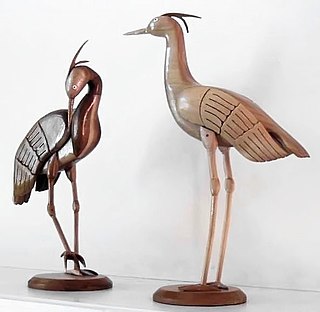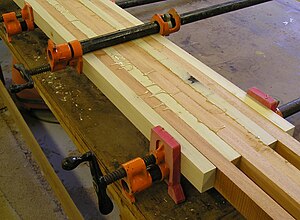
A flange is an external or internal ridge, or rim (lip), for strength, as the flange of an iron beam such as an I-beam or a T-beam; or for attachment to another object, as the flange on the end of a pipe, steam cylinder, etc., or on the lens mount of a camera; or for a flange of a rail car or tram wheel. Thus flanged wheels are wheels with a flange on one side to keep the wheels from running off the rails. The term "flange" is also used for a kind of tool used to form flanges. Pipes with flanges can be assembled and disassembled easily.
A slip joint is a mechanical construction allowing extension and compression in a linear structure.

A clevis fastener is a three-piece fastener system consisting of a clevis, clevis pin, and tang. The clevis is a U-shaped piece that has holes at the end of the prongs to accept the clevis pin. The clevis pin is similar to a bolt, but is only partially threaded or unthreaded with a cross-hole for a split pin. The tang is a piece that fits in the space within the clevis and is held in place by the clevis pin. The combination of a simple clevis fitted with a pin is commonly called a shackle, although a clevis and pin is only one of the many forms a shackle may take.

A biscuit joiner is a woodworking tool used to join two pieces of wood together. A biscuit joiner uses a small circular saw blade to cut a crescent-shaped hole in the opposite edges of two pieces of wood or wood composite panels. An oval-shaped, highly dried and compressed wooden biscuit is covered with glue, or glue is applied in the slot. The biscuit is immediately placed in the slot, and the two boards are clamped together. The wet glue expands the biscuit, further improving the bond.

A hose clamp or hose clip or hose lock is a device used to attach and seal a hose onto a fitting such as a barb or nipple.
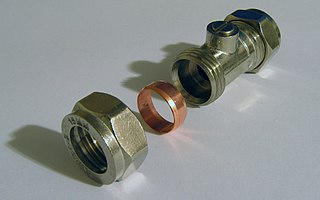
Compression fittings are used in plumbing and electrical conduit systems to join two tubes or thin-walled pipes together. In instances where two pipes made of dissimilar materials are to be joined, the fittings will be made of one or more compatible materials appropriate for the connection. Compression fittings for attaching tubing (piping) commonly have ferrules in them.
This is a glossary of firefighting equipment.

A vise or vice is a mechanical apparatus used to secure an object to allow work to be performed on it. Vises have two parallel jaws, one fixed and the other movable, threaded in and out by a screw and lever.
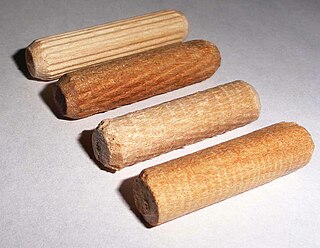
A dowel is a cylindrical rod, usually made from wood, plastic, or metal. In its original manufactured form, a dowel is called a dowel rod. Dowel rods are often cut into short lengths called dowel pins. Dowels are commonly used as structural reinforcements in cabinet making and in numerous other applications, including:

A pipe is a tubular section or hollow cylinder, usually but not necessarily of circular cross-section, used mainly to convey substances which can flow — liquids and gases (fluids), slurries, powders and masses of small solids. It can also be used for structural applications; hollow pipe is far stiffer per unit weight than solid members.

Pocket-hole joinery, or pocket-screw joinery, involves drilling a hole at an angle — usually 15 degrees — into one work piece, and then joining it to a second work piece with a self-tapping screw.

A fitting is used in pipe systems to connect the straight pipe or tubing sections, adapt to different sizes or shapes and for other purposes, such as regulating fluid flow. "Plumbing" is generally used to describe the conveyance of water, gas, or liquid waste in domestic or commercial environments; "piping" is often used to describe the high-performance conveyance of fluids in specialized applications. "Tubing" is sometimes used for lighter-weight piping, especially that flexible enough to be supplied in coiled form.

Pipe fitting or pipefitting is the occupation of installing or repairing piping or tubing systems that convey liquid, gas, and occasionally solid materials. This work involves selecting and preparing pipe or tubing, joining it together by various means, and the location and repair of leaks.

A pipefitter or steamfitter is a tradesperson who installs, assembles, fabricates, maintains and repairs mechanical piping systems. Pipefitters usually begin as helpers or apprentices. Journeyman pipefitters deal with industrial/commercial/marine piping and heating/cooling systems. Typical industrial process pipe is under high pressure, which requires metals such as carbon steel, stainless steel, and many different alloy metals fused together through precise cutting, threading, grooving, bending and welding. A plumber concentrates on lower pressure piping systems for sewage and potable water, in the industrial, commercial, institutional, or residential atmosphere. Utility piping typically consists of copper, PVC, CPVC, polyethylene, and galvanized pipe, which is typically glued, soldered, or threaded. Other types of piping systems include steam, ventilation, hydraulics, chemicals, fuel, and oil.

A skateboard is a type of sports equipment used primarily for the sport of skateboarding. It usually consists of a specially designed maplewood board combined with a polyurethane coating used for making smoother slides and stronger durability. Most skateboards are made with 7 plies of this wood.
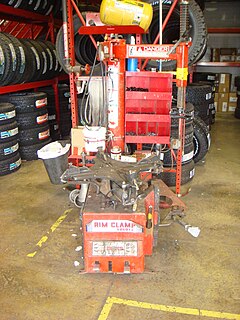
A tire changer is a machine used to help tire technicians dismount and mount tires with automobile wheels. After the wheel and tire assembly are removed from the automobile, the tire changer has all the components necessary to remove and replace the tire from the wheel. Different tire changers allow technicians to replace tires on automobiles, motorcycles and heavy-duty trucks. New tire and wheel technology has improved certain tire changers to be able to change a low profile tire or a run-flat tire.
A pipe support or pipe hanger is a designed element that transfer the load from a pipe to the supporting structures. The load includes the weight of the pipe proper, the content that the pipe carries, all the pipe fittings attached to pipe, and the pipe covering such as insulation. The four main functions of a pipe support are to anchor, guide, absorb shock, and support a specified load. Pipe supports used in high or low temperature applications may contain insulation materials. The overall design configuration of a pipe support assembly is dependent on the loading and operating conditions.

Copper tubing is most often used for the supply of hot and cold tap water, and as a refrigerant line in HVAC systems. There are two basic types of copper tubing, soft copper and rigid copper. Copper tubing is joined using flare connection, compression connection, or solder. Copper offers a high level of corrosion resistance but is becoming very costly.

